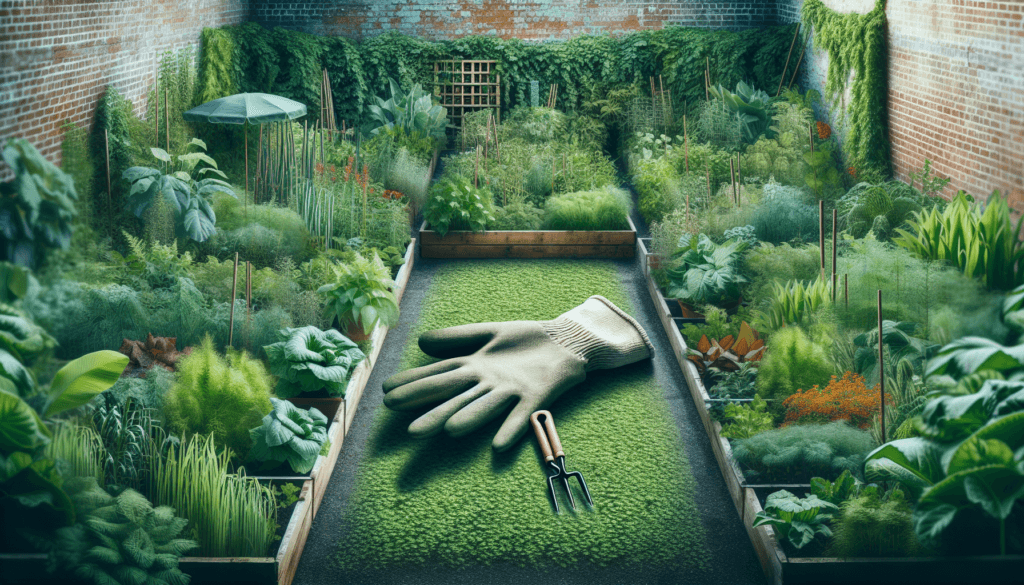Are you an urban gardener looking for effective ways to tackle pesky pests? Look no further! In this article, we will explore various strategies that can help you keep your urban garden thriving and pest-free. From natural repellents to companion planting, we’ve got you covered. So, get ready to arm yourself with knowledge and bid farewell to those unwanted garden intruders!

Natural Pest Control Methods
Biological Controls
One effective way to control pests in your garden is by using biological controls. This method involves introducing natural predators or parasites that feed on the pests, keeping their population in check. For example, ladybugs are known to eat aphids, which can harm your plants. By releasing ladybugs into your garden, you can control the aphid population without resorting to harmful chemicals.
Crop Rotation
Crop rotation is another natural pest control method that can be highly effective. By rotating the crops you plant each season, you can disrupt the life cycle of pests and minimize their impact on your plants. For example, if one crop is susceptible to a particular pest, you can replace it with a different crop that is not affected by the same pest. This helps to prevent the buildup of pests in your garden and maintain a healthy ecosystem.
Companion Planting
Companion planting involves growing certain plants together that have a mutually beneficial relationship. Some plants naturally repel pests, while others attract beneficial insects that feed on pests. For example, planting marigolds can help repel nematodes, a type of soil-dwelling pest, while attracting ladybugs which feed on aphids. By strategically planning your garden and choosing the right companions, you can naturally control pests and promote the overall health of your garden.
Manual Removal
Sometimes, the best way to control pests in your garden is to manually remove them yourself. This can be done by physically picking off pests or using tools like tweezers or traps. Manual removal works well for larger pests such as slugs, snails, or caterpillars that can be easily seen and picked off. By taking the time to inspect your plants regularly and manually remove any pests you find, you can prevent infestations from getting out of control.
Physical Barriers
Fencing
Fencing is an effective physical barrier that can help keep larger pests out of your garden. Erecting a fence around your garden can deter animals like rabbits, deer, or raccoons from entering and damaging your plants. Make sure to choose a sturdy fence material that can withstand the pressure of these animals. Additionally, ensure that the fence is buried at least a few inches into the ground to prevent burrowing pests from entering.
Bird Netting
Bird netting is a great way to protect your fruits and vegetables from bird damage. By draping bird netting over your plants or creating a temporary structure, you can prevent birds from reaching your crops. The netting should be fine enough to prevent birds from getting tangled in it while still allowing sunlight and rainwater to reach your plants.
Row Covers
Row covers are lightweight fabrics that can be placed over your plants to protect them from pests. They create a physical barrier that prevents insects and other pests from reaching your plants. Row covers are especially useful for protecting crops like lettuce or brassicas from common pests like caterpillars or aphids. It’s important to secure the edges of the row covers to the ground to prevent pests from crawling underneath.
Mulching
Mulching is not only beneficial for conserving soil moisture and suppressing weeds, but it can also act as a physical barrier against pests. By applying a thick layer of organic mulch around your plants, you can deter pests from reaching the soil surface. Mulch prevents pests that live in the soil, such as slugs or cutworms, from easily accessing your plants. Additionally, certain types of mulch, like cedar chips or pine needles, can repel pests with their natural scent.

Chemical Pest Control
Pesticides
While natural pest control methods should be the first line of defense, there are situations where chemical pesticides may be necessary. Pesticides are substances specifically designed to kill or control pests. However, it’s important to use them judiciously and follow the instructions carefully to minimize their impact on the environment and beneficial insects. Always opt for organic or low-toxicity pesticides to prioritize the health and safety of your garden.
Insecticidal Soaps
Insecticidal soaps are an environmentally friendly alternative to chemical pesticides. They are made from natural, plant-derived oils like potassium salts of fatty acids. These soaps work by disrupting the cell membrane of soft-bodied insects, causing them to dehydrate and die. Insecticidal soaps are effective against a wide range of pests, including aphids, mites, and scales. They are safe to use and won’t leave harmful residues in your garden.
Horticultural Oils
Horticultural oils, also known as dormant oils or summer oils, are another non-toxic method for controlling pests. These oils are usually made from petroleum or vegetable oils and work by suffocating pests such as mites, aphids, and scales. Horticultural oils are typically applied during the dormant season or early spring to smother overwintering pests and their eggs. They can also be used during the growing season, but avoid applying them when temperatures are high to prevent plant damage.
Attracting Beneficial Insects and Animals
Planting Pollinator-Attracting Flowers
One way to naturally control pests in your garden is by attracting beneficial insects like bees, butterflies, and ladybugs. These insects not only help in pollination but also prey on pests, keeping their populations in check. By planting a variety of pollinator-attracting flowers such as lavender, sunflowers, and wildflowers, you can create a welcoming habitat for these beneficial insects.
Installing Bee Houses
Bees are essential pollinators that play a crucial role in plant reproduction. By installing bee houses in your garden, you can provide shelter for solitary bee species that are excellent pollinators. These bee houses consist of wooden blocks with small holes that mimic the natural nesting habitat of these bees. By offering them a safe place to live and reproduce, you can increase the population of beneficial bees in your garden.
Providing Water Sources
To attract beneficial insects and animals, it’s important to provide them with a water source. This can be as simple as placing shallow dishes filled with water throughout your garden. Adding pebbles or stones to the dishes will provide landing areas for insects, preventing them from drowning. By offering water, you encourage beneficial insects to stay in your garden, increasing their ability to control pests naturally.
Creating Bat Boxes
Bats are nature’s pest control experts, as they consume a large number of insects each night. By installing bat boxes in your garden, you provide a safe and welcoming habitat for these nocturnal creatures. Bat boxes are wooden structures that mimic natural roosting sites, such as tree cavities or the eaves of buildings. By encouraging bats to make your garden their home, you can enjoy natural pest control without the use of chemicals.

Importance of Soil Health
Improving Soil Fertility
Maintaining healthy soil fertility is essential for creating a balanced and pest-resistant garden. By regularly testing your soil and understanding its nutrient needs, you can supply the necessary elements to support plant growth. Healthy plants are more resistant to pests and diseases, as they are better equipped to defend themselves.
Adding Organic Matter
One of the best ways to improve soil health is by adding organic matter. Organic matter, such as compost or well-rotted manure, enriches the soil with essential nutrients and improves its structure. This promotes better root growth and increases the soil’s ability to retain moisture. Healthy soil with good structure supports a diverse microbial community, which can help control pests naturally.
Managing Soil Moisture
Proper soil moisture management is crucial for preventing pest problems. Overly wet or dry soil can weaken plants, making them more susceptible to pests and diseases. It’s important to monitor soil moisture levels and water your plants accordingly. Applying water directly to the soil at the base of the plants, rather than overhead watering, can reduce the chance of fungal diseases and discourage pests from moving into your garden.
Crop Selection and Timing
Choosing Resistant Varieties
Selecting resistant varieties is an effective way to prevent pest problems in your garden. Some plant varieties are naturally more resistant to certain pests, reducing the need for pesticides or other control methods. When choosing seeds or plants, look for varieties labeled as resistant to common pests. This proactive approach can save you time, money, and effort by minimizing the risk of pest damage.
Planting at the Right Time
Proper timing of planting can also help prevent pest problems. By planting your crops at the right time, you can evade pests that are most active during a specific season. For example, planting cool-season crops like lettuce or broccoli in the early spring can help avoid the peak populations of pests that emerge later in the growing season. Understanding the life cycles of pests and the ideal planting times for your crops can greatly reduce pest issues.
Succession Planting
Succession planting involves planting crops in stages, rather than all at once. This technique helps to spread out the harvest and reduces the risk of pest infestations. By staggering your plantings, you can avoid having a large crop of the same plant ready for harvest at once, which can attract pests. Additionally, it allows you to remove spent plants and replace them with new ones, preventing a buildup of pests in your garden.

Regular Garden Maintenance
Weed Control
Regularly removing weeds from your garden is essential for minimizing pest problems. Weeds can provide shelter and a food source for pests, making them more likely to stick around and cause damage to your plants. By regularly pulling or mulching weeds, you eliminate these hiding places for pests and reduce competition for nutrients, water, and sunlight.
Pruning and Trimming
Regular pruning and trimming of your plants can help prevent pest infestations. By removing dead or damaged branches, you eliminate potential entry points for pests. It also improves airflow and sunlight penetration, creating an unfavorable environment for pests that thrive in damp, shaded areas. Pruning and trimming can also help shape your plants and promote healthy growth.
Proper Watering
Proper watering techniques can go a long way in preventing pest problems in your garden. Overwatering can create favorable conditions for fungal diseases and attract pests that prefer damp environments. On the other hand, underwatering can weaken plants, making them more susceptible to stress and pest damage. Watering your garden deeply and at the base of the plants, rather than the foliage, encourages strong root development and helps prevent pest issues.
Removing Garden Debris
Regularly removing garden debris, such as fallen leaves, dead plants, or fruits, can help prevent pest infestations. These debris can provide hiding places and food sources for pests, allowing them to multiply and cause damage to your plants. By cleaning up your garden regularly, you remove potential breeding grounds and reduce the risk of pests taking hold.
Promoting Biodiversity
Creating Habitat for Wildlife
Promoting biodiversity in your garden is not only beneficial for the environment but can also help control pests naturally. By creating habitats that attract wildlife like birds, toads, or frogs, you encourage them to take up residence in your garden. These animals are natural predators of pests and can help keep their populations in check. Provide shelter options, such as birdhouses, rock piles, or small ponds, to create a welcoming habitat for wildlife.
Planting Native Species
Planting native species in your garden has many benefits, including natural pest control. Native plants have co-evolved with local insects and are more resistant to their natural predators. By including native plants in your garden, you can support local ecosystems and attract beneficial insects that feed on pests. Native plants are also well-adapted to the local climate and require less maintenance, making them an excellent choice for urban gardens.
Mulching with Leaves and Wood Chips
Using organic mulches like leaves or wood chips can help promote biodiversity in your garden. These mulches provide habitat and food sources for beneficial insects, such as ground beetles or spiders, which feed on pests. Additionally, mulching with organic materials improves soil health over time, creating a favorable environment for beneficial organisms. Spread a layer of mulch around your plants, keeping it several inches away from the stems to prevent rot.

Monitoring and Early Detection
Regular Inspections
Regularly inspecting your plants is crucial for early pest detection and control. Take the time to closely observe your plants for any signs of pest activity, such as discolored leaves, chewed foliage, or webbing. By catching pest problems early, you can take immediate action and prevent them from spreading or causing significant damage. Regular inspections also allow you to monitor the effectiveness of your pest control strategies and make necessary adjustments.
Using Traps and Monitors
Traps and monitors are effective tools for monitoring and controlling pests in your garden. Sticky traps can be placed near plants to catch flying pests like whiteflies or gnats. Yellow traps are particularly attractive to many pests. Additionally, pheromone traps can be used to capture specific pests that are attracted to certain scents. By regularly checking these traps, you can monitor pest populations and take action as needed.
Identifying Pest Damage
Being able to identify pest damage is essential for effective pest control. Different pests cause distinct types of damage to plants. For example, caterpillars may leave large holes in leaves, while aphids can cause curling or wilting. By learning how to identify the specific signs of pest damage, you can narrow down the potential culprits and choose the appropriate control methods. Proper identification also helps in determining the best prevention strategies for future seasons.
Educating and Engaging the Community
Sharing Knowledge and Tips
One way to promote natural pest control methods in urban gardening is by sharing your knowledge and tips with others. Engage with your community by sharing your experiences through gardening blogs, social media groups, or community gardening forums. By providing information on natural pest control methods and their benefits, you can inspire others to adopt sustainable gardening practices.
Organizing Workshops and Events
Organizing workshops and events focused on natural pest control is another great way to educate and engage the community. Collaborate with local gardening clubs, community centers, or schools to host informative sessions on topics like companion planting, organic pest control, or pollinator-friendly gardening. These events provide an opportunity for people to learn practical techniques and interact with like-minded individuals who share a passion for sustainable gardening.
Collaborating with Local Organizations
Collaborating with local organizations, such as environmental groups or gardening associations, can amplify your efforts in promoting natural pest control in urban gardening. Join forces to organize community projects, share resources, or host joint initiatives. By working together, you can reach a wider audience and make a greater impact in creating awareness and advocating for sustainable gardening practices in your community.
In conclusion, implementing natural pest control methods in your urban garden not only helps protect your plants but also promotes a healthier and more sustainable environment. By utilizing biological controls, physical barriers, chemical alternatives, and promoting biodiversity, you can minimize pest damage without harming the ecosystem. Additionally, focusing on soil health, crop selection, regular garden maintenance, monitoring, and community engagement will ensure a thriving and pest-free garden for years to come. Remember, a little friendly effort goes a long way in creating a harmonious and pest-resistant urban garden. Happy gardening!


